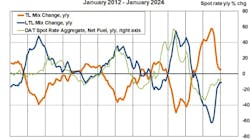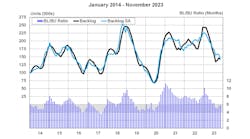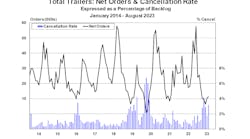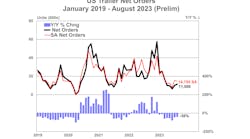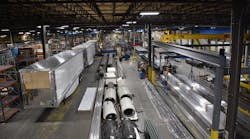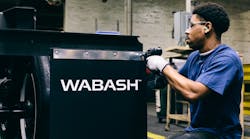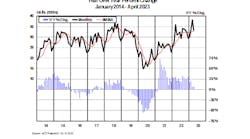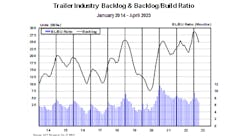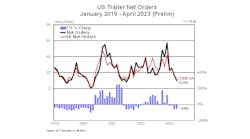ELI Lustgarten said the recession is over and freight will start moving at a more rapid pace, but the “new normal level of demand” will mean truck and trailer sales will be a far cry from the good ol' days.
In “Industry and Financial Trends and Forecasts for the Next Decade,” Lustgarten, senior vice-president of Longbow Securities, said that by 2011, Class 8 truck sales will be in the 175,000 to 225,000 range, but prior level peaks of over 300,000 are unlikely until at least the next emission cycle. He said the estimates are for 135,000 this year, 195,000 in 2011 and 250,000 by 2012.
That “new normal” will be seen in other areas:
-
The automotive market is unlikely to return quickly to 16 to 17 million car sales that prevailed from 1999-2005 — “perhaps 12 million to 13.5 million is the new norm.”
-
Housing is unlikely to return quickly to two million starts — “the new norm may be 1.3 to 1.6 million over the next few years, with cautious funding keeping starts below 1 million at least into 2011.”
-
Construction and mining, engines and turbines, railcars and other heavy equipment face a slow recovery through 2012 to levels likely below 2006 to 2008.
-
Farm equipment end-market demand growth is dependent on global economic growth, global demand, and weather. Growth could resume as early as 2011.
-
Electrical markets/alternative energy growth probably resumes after 2010.
Lustgarten said the domestic economic environment is improving, with rising industrial production.
“Total freight ton-miles declined about 2.9% in 2008 and nearly 8% for all of 2009,” he said. “Look for growth of at least 2.5% in 2010 and about 4% in 2011. Truck ton-miles were down about 5.7% in 2008 and about 8% in 2009, and are likely to rise at least 2.5% in 2010 and 5% to 6% in 2011.”
He said truck fleet utilization is undergoing a slow recovery, at 85% to 90%, after bottoming out at 72% in the second quarter of last year. He said substantial excess capacity needs to be absorbed before there is a major upturn in demand, with the timing likely sometime in 2011.
“The growth in freight tonnage will turn positive on a year-over-year basis in the first half of this year,” he said. “The existing stock will handle the freight upturn. There will be demand increases for used trucks and new trucks with 2009 engines, which cost less than new 2010 engines. Truck production in the first quarter will remain strong, reflecting an inventory of pre-2010 engines. The transition from old engines to 2010 engines will likely begin late in the second quarter. The economic recovery, increased truck-capacity utilization, and improving trucker bottom-line will translate into replacement of aging equipment in 2011 and 2012.”
He said the early signposts for the end of the recession have been met: Housing data has begun to flatten and/or improve in terms of new home sales and starts; global purchasing manager indexes have begun to rise; financial risk metrics have begun to normalize; commodity prices have stabilized and/or begun to rise; global equity markets have improved; and financial markets have stabilized.
The economic recovery, he said, is born of a combination of government policy efforts such as: stimulus packages recently passed by the Obama Administration (deficit spending), and the economy's built-in recuperative powers (oil down from $147 peak, with gasoline prices generally in the $2 to $3 range).
“The US uses about 140 billion gallons per year, suggesting the lower fuel prices may provide a huge stimulus,” he said.
Next Page: Fed economist: Look for significant growth this year
Massive stimulus programs are in place for 2009 and 2010. The US stimulus package will carry a price tag of $787 billion over two years. Tax breaks of one sort or another will account for upwards of $288 billion. The remaining $499 billion is composed of outlays for food stamps to infrastructure (roads, bridges, mass transit, waterworks, electrical grid, environmental, alternative energy) to computerizing health care records. He said it's designed to create upwards of 3.5 million jobs over several years, compared to 2.5 million jobs lost in 2008.
He said consumer spending is beginning to improve, with the third quarter coming in at 3.4% in October (revised to 2.9% in November).
Auto sales improved from the Cash for Clunkers program, going from 9.2 million average monthly sales in September to 10.4 million, 10.9 million and 11.25 million by the end of the year.
He said we can expect a slow industrial recovery in 2010.
“We have dug a deep hole to climb out of,” he said. “Manufacturing capacity utilization is now in the high 60s, compared to a more normal 78% to 80%. Virtually every industrial sector is currently over-capacitized globally.”
There is little need for capital equipment for expansion in 2010.
“There is a need to absorb excess capacity,” he said. “The only exception may be for new products. Production increases will be mostly related to end-of-inventory liquidation; the production level will more closely match end-market sales. Smaller, lighter equipment is likely to outperform heavy equipment, which could decline through 2010. Real growth of demand for equipment is likely to return in 2011, unless policy mistakes are made. US government stimulus programs will likely play a greater role in 2011-2012 and beyond than in 2009-2010.”
Fed economist: Look for significant growth this year
The economy should grow significantly in 2010, says William Strauss, senior economist and economic advisor at the Federal Reserve Bank of Chicago.
Participating in the “Industry and Financial Trends and Forecasts for the Next Decade” at Heavy Duty Dialogue, Strauss said that after the worst economic downturn seen in the past 30 years, “we should be looking at pretty significant growth rates for 2010. In the 1980s recovery, the growth rate was 7% for the next six quarters. Our growth rate is less than half that for two reasons: (1) the financial crisis, which led to this whole thing, is still upon us, and businesses, especially smaller businesses, are finding financing a problem; and (2) consumers have taken on a new approach to savings.”
He said savings as a percentage of disposable personal income increased to 6% in 2009.
“Long term, that's good for the economy, but because consumers represent so much of GDP, they are saving more and spending less, and that's going to weigh down growth rates,” he said.
The GDP growth is forecast to grow slightly above trend in 2010 (2.9%) and 2011 (3.2%).
“If the financial markets are not going to allow businesses and consumers to do what they want to do in 2010, that will delay the recovery to 2011,” he said. “Typically, a recession last 11 months. The longest we've seen was 16. This one, if it ended in June, will be 18 months. GDP normally falls an average of 1.7%. The worst seen was 3.2% in the 1980s. But this was worse — 3.8%.”
He said the unemployment rate is forecast to peak at 10.2% early this year and then begin to edge lower, but will still be around 9% at the end of 2011.
Inflation is anticipated to rise by 1.7% this year and 2% next year.
Industrial output fell quite sharply — 16.6%, the most in 50 years — but has risen strongly over the past five months. The downturn in manufacturing was the deepest over the past 50 years, but the recovery has been nearly 24%. Manufacturing capacity utilization fell to the lowest level in more than 70 years, “so even with these large gains, we're still looking at levels of operation that still are relatively low at end of this year.”
Industrial production was down 5% in 2009, but is forecast to rise 4.6% this year and 4.3% in 2011.
“I'm actually more optimistic,” Strauss said. “I think numbers of over 5% are more likely.”
